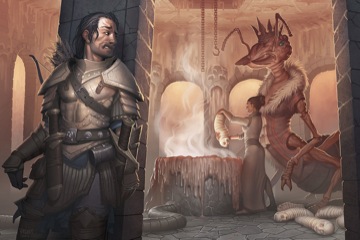Stealth Playtest
Tuesday, August 23, 2011
Here at Paizo, the design team has a host of challenges. Some of the greatest challenges come when dealing with the rules of our game that don't work as well as we would like. For a number of weeks we have been talking about the issues concerning the Stealth skill. Over the course of those conversations we have come up with many ideas to improve this skill and make its use both clearer and more playable.
So, here is our crazy idea: We are thinking about just rewriting the skill. This is our first stab at a rewrite, but before we make any definitive change, we want to unleash our crazy ideas to you—the Pathfinder players—to poke holes in, give us input on, and playtest. The following changes to the Stealth rules are by no means final, nowhere near official, and definitely not usable in Pathfinder Society. They're here for you to read, think on, playtest, and then for you to give us feedback. We will be listening for the next week. Have fun!
Stealth
(Dex; Armor Check Penalty)
You are skilled at avoiding detection, allowing you to slip past foes or strike from an unseen position. This skill covers hiding and moving silently.Check: Your Stealth check is opposed by the Perception check of anyone who might notice you. Usually a Stealth check is made at the start of a free, move, or swift action when you start that action with either some kind of cover (except for soft cover) or concealment. You can always spend a swift action to stay immobile and make a Stealth check. You cannot spend a free action to initiate a Stealth check, but if you spend a free action while under the effects of Stealth, you must make a new Stealth check in order to continue the effects of Stealth. You can move up to half your normal speed and use Stealth at no penalty. When moving at a speed greater than half and up to your normal speed, you take a –5 penalty. It's usually impossible to use Stealth while taking an immediate action, standard action, or a full-round action, unless you are subject to greater invisibility or a similar effect, you are sniping (see below), or you are using a standard action to ready an action. When you make your Stealth check, those creatures that didn't succeed at the opposed roll treat you as invisible until the start of your next action or until the end of your turn if you do not end your turn with cover or concealment. When you use Stealth, creatures that are observing you (creatures that you didn't have cover or concealment from) or that succeed at the opposed check do not treat you as invisible.
A creature larger or smaller than Medium takes a size bonus or penalty on Stealth checks depending on its size category: Fine +16, Diminutive +12, Tiny +8, Small +4, Large –4, Huge –8, Gargantuan –12, Colossal –16.
Attacking from Invisibility: Usually making an attack against a creature ends the invisible condition. If during your last action were invisible to a creature, you are still considered invisible when you make the first attack of that new action.
Other Perception Checks: If a creature makes a Perception check as a move action to notice an invisible creature, the DC of the Perception check is the invisible creature's last Stealth check. This is also the case if a creature makes a Perception check to notice an invisible creature because the perceiving creature is entering an area where it could possibly notice an invisible creature.
Sniping: If you already are invisible to a target and you are 10 feet from that target, as a standard action, you can make one ranged attack against that target and immediately make an opposed Stealth check to stay invisible. You take a –20 penalty on your Stealth check when attempting to snipe.
Creating a Diversion to Hide: If you do not have cover or concealment, as a standard action, you can attempt a Bluff check opposed by the Perception of opponents that can see you. On a success, you become invisible to those creatures and can move up to half your speed. When you do this, you take a –10 penalty on the Bluff check.
Action: Usually making a Stealth check is not an action. Using Stealth is part of the action are taking.
Special: If you are subject to the invisibility or greater invisibility spells or a similar effect, you gain a +40 bonus on Stealth checks while you are immobile, or a +20 bonus on Stealth checks while you're moving. If you have the Stealthy feat, you get a bonus on Stealth checks (see Chapter 5).
Stephen Radney-MacFarland
Designer
We have updated our Privacy Policy.
Paizo.com uses cookies. You can block paizo.com from using cookies within your browser settings, but doing so will hinder site functionality.
More information can be found in our Privacy Policy.
